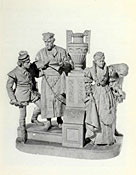About The Sculptor John Rogers (1829 - 1904)
The plaster statue groups made by John Rogers (1829-1904) from 1859 until 1893, were so appealing in late Victorian America that scarcely a family of reasonable means and taste did not possess one.

John Rogers portrayed ordinary, everyday, urban and rural people doing ordinary, everyday things. Through his Rogers Groups, he offered an unrivaled transcript of the manners, sports, amusements, social customs, domestic interests, costumes, and even modes of furnishing of the period. John Rogers made statues of Civil War soldiers, family groups, literary topics, theater scenes and historical figures. His statues ranged from eight to forty-six inches tall.
John Rogers was born in Salem, Massachusetts, on October 30, 1829, a descendant of the original settlers of the colony. He gave early evidence of artistic interests and even as a young child, showed a taste and talent for drawing. However, it was the feeling of his parents that an artist’s life was little better than a vagabond, and in 1845, at the age of sixteen, after what was considered a good education in the town schools, he was placed in a dry-goods store in Boston, with the intention of learning the business. However, John Rogers felt certain he was not suited for this line of work, and in 1848, he entered a machine shop in Manchester, New Hampshire, to learn the trade. During this period, John Rogers devoted himself to his art with enthusiasm and his attention was first drawn to sculpture, in particular. John Rogers began to model in clay in his leisure hours. In 1856, John Rogers sought work in Hannibal, Missouri, and in 1858, he visited Europe to continue his formal education in sculpting. On his return in 1859, he went to Chicago, where he modeled, for a charity event, "The Checker Players," a group in clay, which attracted much attention. This event marked the beginning of an unusual career.
Between 1860 and 1893, John Rogers sculpted approximately 85 different patented groups of statuary. During that period, some 25 workmen in his New York factory turned out thousands of plaster castings of his works. Of some subjects executed by John Rogers, only a few copies were cast and sold. Of other John Rogers Groups, thousands were sold. In John Rogers' 30-year career, the artist sold over a million dollars of sculpture, a lot of money for art in those days. It is estimated that a total of 80,000 – 100,000 castings of his groups were produced during John Rogers’ lifetime. By the 1880s, it seemed that families who did not have a John Rogers Group were not conforming to the times. Even Abraham Lincoln had a John Rogers Group.
John Rogers statuary were moderately priced, averaging $14.00 apiece. Rogers' sculptures became a nationwide vogue, and were seen in virtually every art and bookstore window. The appearance of a new John Rogers sculpture was a major event covered by reporters from the nation's newspapers.

John Rogers’ sculpture of "The Slave Auction," which was exhibited in New York in 1860, brought him to the notice of the general public. This was the forerunner of the well-known series of Civil War statuettes which included, among others, the "Picket Guard" (1862), "One More Shot" (1864), "Union Refugees” (1864), "Taking the Oath and Drawing Rations" (1866), "Wounded Scout" (1864), and "Council of War" (1868).
John Rogers’ works on social subjects, most of which were sculpted following the Civil War, were also very popular. Among the most commonly found John Rogers Groups today are "Coming to the Parson" (1870), " We Boys" (1872), "The Favored Scholar" (1873), "Going for the Cows" (1873) and "Checkers up at the Farm" (1875).

John Rogers also sculpted several statues illustrating passages from literature, including a series of three groups depicting Washington Irving's "Rip Van Winkle" (1871) as well as "Why Don't You Speak for Yourself?" (1885) from Longfellow's "The Courtship of Miles Standish." In addition, John Rogers’ frequently used subjects from Shakespeare, including “The Wrestlers” (1881) from “As You Like It", "Is It So Nominated in the Bond?" (1880) from “The Merchant of Venice" and "Ha! I like Not That" (1882) from "Othello, and others.
John Rogers was also commissioned to execute a number of monumental sculptures, including the statue of General John F. Reynolds (1881-1883), which stands before the Philadelphia City Hall, and in 1887, he exhibited "Ichabod Crane and the Headless Horseman," a huge bronze group.
Our 1971 book on John Rogers was republished in 2001, and we have a few extra copies if you would like to acquire one. The book chronicles each John Rogers Group with a photograph, size, patent or design date, and pertinent anecdotes. It’s useful today as a reference for interpreting life in Victorian America and today’s collectors will covet the pictures, personal letters, advertising, and social commentary presented in the text.
My family and I have been active buyers of John Rogers Groups for over forty years. If you have a John Rogers statue that you are interested in selling, we would be pleased to hear from you. If you have a John Rogers statue and would just like to “talk Rogers” also feel free to give us a call or send us an email.
Please click here for a picture of every John Rogers Group of Statuary that Rogers published. Find your statue, and let’s hear from you!